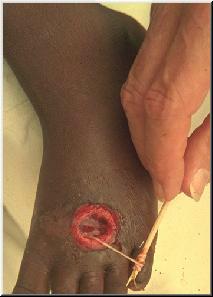Guinea worm disease, a debilitating parasitic infection that has ravaged African and Asian populations since antiquity, may be on the verge of being eradicated. Guinea worm disease would be stamped from human populations within two years, making it the second disease humankind has eliminated—the first being smallpox.
Guinea worm disease afflicts the poorest of the poor, those living in areas with poor sanitation and minimal access to primary health care. Often these populations are burdened by a variety of other devastating diseases, including malaria. The culprit in Guinea worm disease is a roundworm parasite called Dracunculus medinensis, whose larvae dwell in microscopic water fleas. People contract the disease by drinking unfiltered water harboring larvae-infected fleas. Once swallowed and passed through the stomach, these larvae burrow into the intestinal tissue and reproduce. The offspring are worms that migrate through the body tissues on a slow journey toward the skin. By the time the worm completes its trek (about one year later), it resembles a giant spaghetti noodle measuring as long as two or three feet. Victims of the disease sometimes see the worm moving beneath their skin as it prepares to break the surface. The worm eventually pushes its way out of the skin, causing an excruciating burning sensation.
One of the only ways to relieve this pain is by dipping the infected area in the local water source. Sadly, this only helps the worm perpetuate its life cycle. The worm releases millions of larvae into the water, which are then eaten by water flees, the very critters responsible for transmitting the worm to the person in the first place.
Efforts to rid populations of Guinea worm disease have been hugely successful. Working with local governments and international health organizations, the Carter Center has helped slash the number of infections from 3.5 million in 1986 to fewer than 5,000 cases today (a 99.7 percent decline). There once were 20 African and Asian countries afflicted by the Guinea worm. Today there are only six: Sudan, Ghana, Mali, Ethiopia, Niger, and Nigeria.
How does Guinea worm disease manifest itself?
For the first nine-to-12 months, you don’t know you have Guinea worm disease. The [first] symptoms are malaria-like: fever, nausea, chills, and absolutely no energy. [A few weeks later], the worm forms a large burning skin ulcer, causing intense, localized pain. As soon as the ulcer forms, you can barely move that part of the body. In the middle of the ulcer, a blister forms where the worm emerges. It takes at least 10 days for the worm to exit. It’s agonizing. There is no way you can walk if it’s on the leg or the foot. You can have multiple worms coming out different places. You can wrap a stick around the worm and pull the worm every other day until it resists, pull it and coax it out. But if a worm pulls back inside the body, it can calcify, cut off blood supply, and cause paralysis.
Is there a treatment for Guinea worm disease?
There is no treatment.




Leave a comment